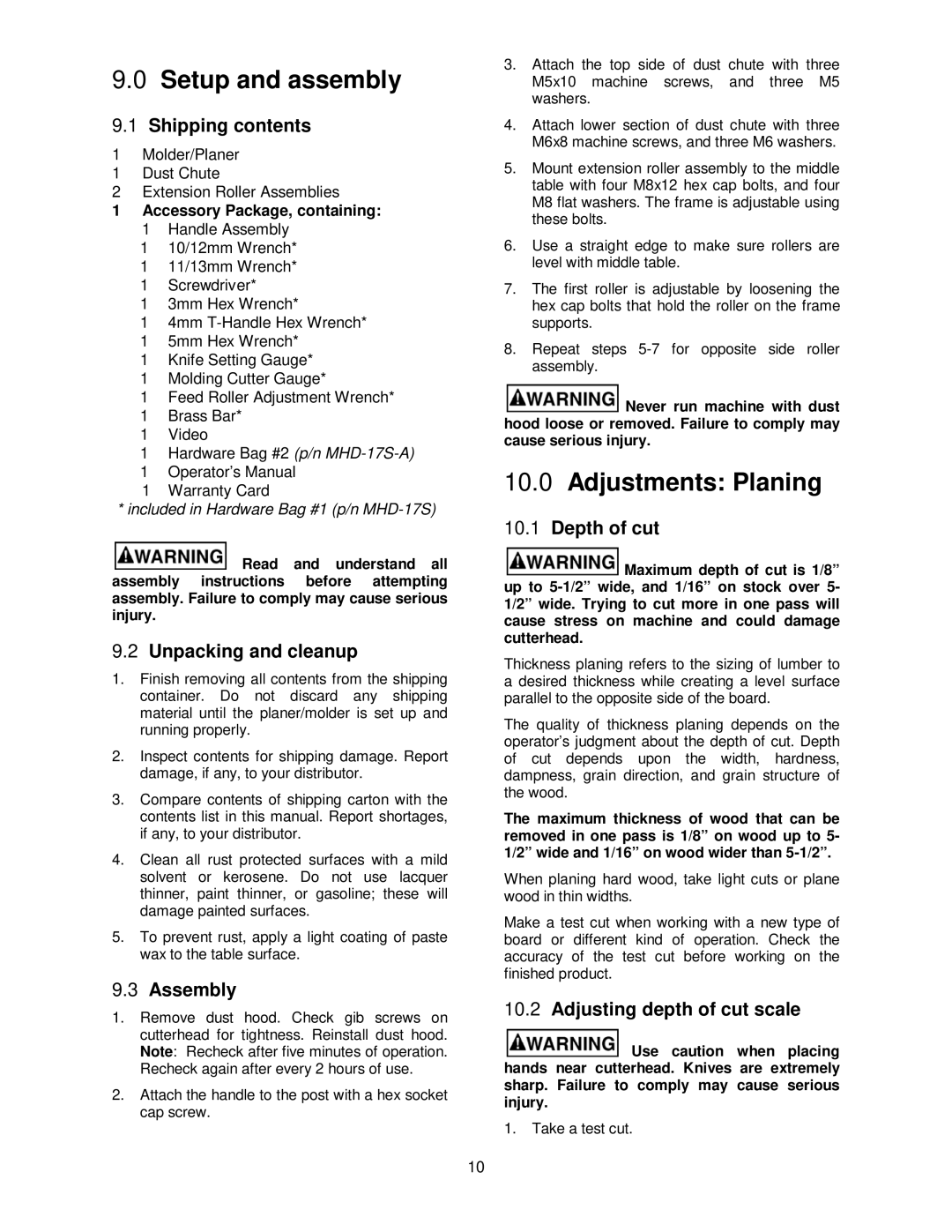9.0Setup and assembly
9.1Shipping contents
1Molder/Planer
1Dust Chute
2Extension Roller Assemblies
1Accessory Package, containing: 1 Handle Assembly
110/12mm Wrench*
111/13mm Wrench*
1Screwdriver*
13mm Hex Wrench*
14mm
15mm Hex Wrench*
1Knife Setting Gauge*
1Molding Cutter Gauge*
1Feed Roller Adjustment Wrench*
1Brass Bar*
1Video
1Hardware Bag #2 (p/n
1Operator’s Manual
1Warranty Card
*included in Hardware Bag #1 (p/n
![]() Read and understand all assembly instructions before attempting assembly. Failure to comply may cause serious injury.
Read and understand all assembly instructions before attempting assembly. Failure to comply may cause serious injury.
9.2Unpacking and cleanup
1.Finish removing all contents from the shipping container. Do not discard any shipping material until the planer/molder is set up and running properly.
2.Inspect contents for shipping damage. Report damage, if any, to your distributor.
3.Compare contents of shipping carton with the contents list in this manual. Report shortages, if any, to your distributor.
4.Clean all rust protected surfaces with a mild solvent or kerosene. Do not use lacquer thinner, paint thinner, or gasoline; these will damage painted surfaces.
5.To prevent rust, apply a light coating of paste wax to the table surface.
9.3Assembly
1.Remove dust hood. Check gib screws on cutterhead for tightness. Reinstall dust hood. Note: Recheck after five minutes of operation. Recheck again after every 2 hours of use.
2.Attach the handle to the post with a hex socket cap screw.
3.Attach the top side of dust chute with three M5x10 machine screws, and three M5 washers.
4.Attach lower section of dust chute with three M6x8 machine screws, and three M6 washers.
5.Mount extension roller assembly to the middle table with four M8x12 hex cap bolts, and four M8 flat washers. The frame is adjustable using these bolts.
6.Use a straight edge to make sure rollers are level with middle table.
7.The first roller is adjustable by loosening the hex cap bolts that hold the roller on the frame supports.
8.Repeat steps
![]() Never run machine with dust hood loose or removed. Failure to comply may cause serious injury.
Never run machine with dust hood loose or removed. Failure to comply may cause serious injury.
10.0Adjustments: Planing
10.1Depth of cut
![]() Maximum depth of cut is 1/8” up to
Maximum depth of cut is 1/8” up to
Thickness planing refers to the sizing of lumber to a desired thickness while creating a level surface parallel to the opposite side of the board.
The quality of thickness planing depends on the operator’s judgment about the depth of cut. Depth of cut depends upon the width, hardness, dampness, grain direction, and grain structure of the wood.
The maximum thickness of wood that can be removed in one pass is 1/8” on wood up to 5- 1/2” wide and 1/16” on wood wider than
When planing hard wood, take light cuts or plane wood in thin widths.
Make a test cut when working with a new type of board or different kind of operation. Check the accuracy of the test cut before working on the finished product.
10.2Adjusting depth of cut scale
![]() Use caution when placing hands near cutterhead. Knives are extremely sharp. Failure to comply may cause serious injury.
Use caution when placing hands near cutterhead. Knives are extremely sharp. Failure to comply may cause serious injury.
1.Take a test cut.
10
